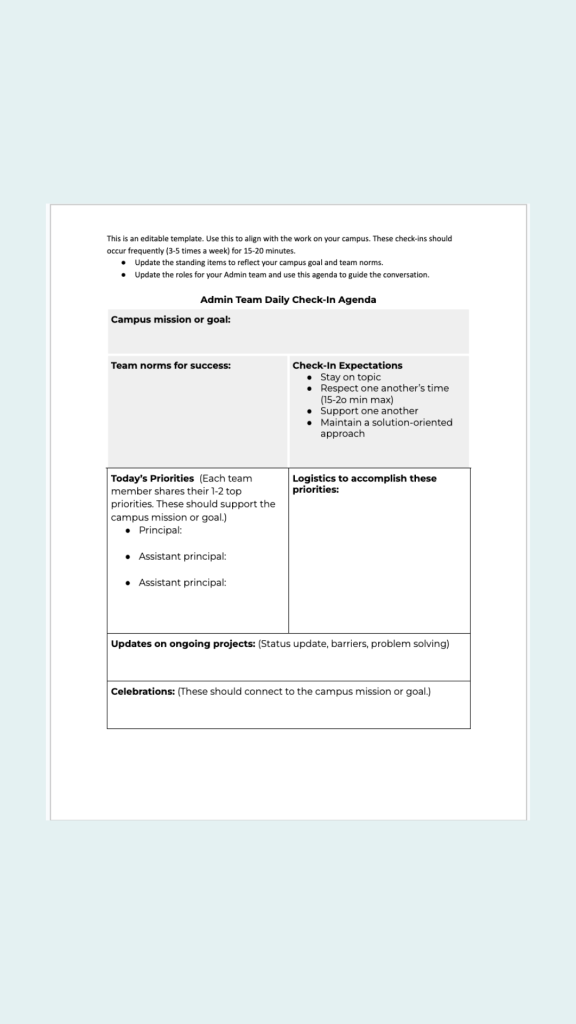Schools are highly complex environments, with numerous systems, stakeholders, and components interacting and impacting one another. It’s palpable when the school functions smoothly, and you can sense it in everything it does. And when it isn’t operating well, the converse is true.
As with most things, the foundation of the school must be solid. The school leadership lays that foundation together by impacting the direction of the campus, setting the expectations of all stakeholders, and monitoring the success of these goals and expectations throughout the year. A cohesive and well-functioning leadership team will yield improved campus culture, student success, and overall synergy of the campus functions.
Develop a strong administrative team on your campus with our Leadership Collaborative Network!
The Power of Alignment
Alignment within a school leadership team is more than mere agreement on paper; it’s a shared commitment to ensure student success and campus improvement. Here are some key reasons why alignment is indispensable:
Unified Work
When every administrative team member aligns with the school’s mission and goals, it creates a powerful synergy. This unity ensures that everyone moves in the same direction, amplifying the impact of their efforts. All organizational and personal goals work in concert to support the overall mission. Every staff member’s goal should be aligned and supported by the campus and student growth goals to ensure movement toward success.

When the leadership team is unified in its goals, it has shared criteria that it can apply to any decisions that need to be made. There are no surprises in the work that is being done or decisions that are being made because there is a common understanding of the campus’s success metric.
Efficient and Consistent Operations
A well-aligned leadership team operates like a well-oiled machine. Clear communication channels, defined roles, and shared priorities streamline decision-making processes and optimize resource utilization. Students, teachers, and parents benefit from the consistency. Alignment ensures that messages conveyed by different leadership team members are congruent, providing clarity and stability within the school community. This improves the efficiency of communication and decision-making processes.
Set the Model for Collaboration
Alignment fosters a culture of collaboration and trust among team members. Effective school leadership sets the expectation that staff collaborates to benefit the students and the campus. We see this in professional learning communities and shared decision-making committees, for example.
It’s up to the administrative team to model this expectation. When individuals understand and respect each other’s perspectives, they can work together more effectively, leveraging diverse talents and experiences. The administrative team must demonstrate how to manage communication and conflict and set personal issues aside to promote the best interests of the campus community. When the leadership team walks this walk, it’s much easier for the staff to fall into step.
Challenges of Conflict Among School Leaders
While the benefits of alignment are undeniable, achieving it is not always straightforward. Conflict among school leaders can significantly impede progress and hinder student and campus growth. Here are some common issues associated with conflict:
Competing Goals Stagnate Student Growth
When leadership team members have conflicting priorities, it can lead to competing agendas and fragmented efforts, diluting the impact of initiatives. This prevents any synergy from developing and creates siloed work. All the staff might be working extremely hard, but if there isn’t a unified direction for the campus and all its stakeholders, the impact is minimal.
Erosion of Campus Culture and Poor Job Satisfaction
Poor communication or misunderstandings can breed resentment and undermine trust among team members, creating barriers to effective collaboration. Power struggles may arise without clear roles and responsibilities, creating discord within the leadership team and diminishing its effectiveness.
When the administrative team experiences this, they become unhappy in their work, which trickles down to all aspects of the campus. This can take a toll on campus morale and customer service from the front office staff and negatively impact staff and student retention.
Stifled Innovation
Conflict can stifle creativity and innovation, as team members may hesitate to propose new ideas or challenge the status quo for fear of reprisal or rejection. On a campus, there are plenty of decisions for leaders to make and problem-solve each day. If the leadership team has a culture of blame and conflict, your team is less likely to find solutions to the issues that crop up.
Strategies to Promote Alignment
Working with others will always present a challenge, especially in the fast-paced environment of a campus. There is never enough time to do everything we need to. For this or other reasons, campus principals and assistant principals might not allocate the time to prioritize alignment.
However, we make time for the things that matter. It is easy to see how a cohesive leadership team can impact overall student success and campus growth. Creating this culture of cohesion among campus administrators is achievable with deliberate effort and strategic interventions. Here are some strategies to foster alignment:
Clear Goal and Mission
Establish a clear and compelling vision for the school, supported by specific, measurable goals. When everyone is aligned with a common purpose, it becomes easier to prioritize actions and make decisions that advance the collective agenda.
Ensure that this mission and goal is present in all the daily work- it needs to be the compass to help navigate challenging decisions; all stakeholders need to live it and breathe it. It must be a focus regularly. To support success and commitment to these goals, define clear roles and responsibilities for each leadership team member.
Norms for Collaboration
Establish norms or ground rules that govern how the administrative team operates. Some areas to consider when establishing the norms for work are:
- When conflict arises (it will), how do we navigate it to maintain the team’s success and integrity?
- What are the preferred methods for communication among the team? Different team members will have different preferences for modalities- ensure alignment and clarity on how to leverage communication effectively.
- What will the decision-making processes look like within the team? What is the mission that we will use to guide our decision-making processes? How do we clarify our understanding once a decision has been made? How will we share decisions with staff?
Addressing some of these complicated dynamics proactively will allow the team to have a clear road map when the pace picks up and emotions are heightened.
Regularly Scheduled Administrative Team Check-in Meetings
Regular meetings allow team members to share updates, discuss challenges, and align their efforts. Set a cadence for check-in meetings, ensuring they occur frequently enough to maintain momentum but not so often that they become burdensome.
These check-ins should be a quick touchpoint for the team; they can occur 3-5 times a week for 15-20 minutes. Some topics you might want to cover are:
- Today’s Priorities: What are each team member’s top 1-2 priorities for the day? (Remember that these priorities should impact the overall campus goal.)
- Logistics: What scheduling adjustments need to be made to support each admin team member’s priority for the day? Do they need 45 min of uninterrupted work time? Do they need time to collaborate with another team member?
- Updates and accountability: Are there status updates on ongoing projects that need to be shared? Are there any barriers that are preventing the work from moving forward? How can the team support you?
- Celebrations: Were there any wins or celebrations that we can share? (Remember to connect these wins to the overall campus goals.)

These check-ins allow for transparency and accountability. The frequent communication promotes opportunities for collaboration and support of one another’s priorities and keeps the overall campus mission front of mind. Download our editable Admin Team Check-In template to keep these check-ins focused and productive.
Conclusion
As Babe Ruth once said, “The way a team plays as a whole determines its success. You may have the greatest bunch of individual stars in the world, but if they don’t play together, the club won’t be worth a dime.”
Alignment within an administrative team is the linchpin of success, driving cohesion, collaboration, and student and campus success. By prioritizing alignment and implementing strategies to promote it, school leaders can navigate challenges more effectively and unlock the full potential of their campus.
Natalie is an Educator Evaluation and Leadership Administrative Specialist at ESC Region 13.






Add comment